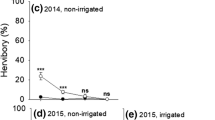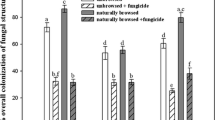Abstract
Herbivory by large animals is known to function as a selection pressure to increase herbivory resistance within plant populations by decreasing the frequency of genotypes possessing large, erect canopies. However, the increase in herbivory resistance of the remaining genotypes in the population may potentially involve a tradeoff with competitive ability. The perennial bunchgrass Schizachyrium scoparium was grown in a transplant garden to test the hypothesis that late successional plant populations with a history of grazing are at a competitive disadvantage relative to conspecific populations with no history of grazing were found to possess a greater competitive ability than plants with no grazing history in the absence of herbivory. This unexpected response resulted from the capacity of plants with a history of grazing to recruit a greater number of smaller tillers than did plants with no grazing history. This response was only significant when plants with a history of grazing were nondefoliated and grown with the weakest of the mid-successional competitors, indicating that both defoliation and intense interspecific competition can mask the architectural expression of herbivore-induced selection. Individual tillers did not display any architectural differences between plants with contrasting grazing histories other than mean tiller weight. These data confirm that herbivory by domestic cattle may function as a selection pressure to induce architectural variation in grass populations within an ecological time frame (ca <-25 yrs).
Similar content being viewed by others
References
Alexander K. I. & Thompson K. 1982. The effect of clipping frequency on the competitive interaction between two perennial grass species. Oecologia 53: 251–254.
Björkman C. & Anderson D. B. 1990. Trade-off among antiherbivore defences in a South American blackberry (Rubus bogotensis). Oecologia 85: 247–249.
Briggs M. A. & Schultz J. C. 1990. Chemical defense production in Lotus corniculatus L. II. Trade-offs among growth, reproduction and defense. Oecologia 83: 32–37.
Briske D. D. 1991. Developmental morphology and physiology of grasses. In: Heitschmidt R. K. and Stuth J. W. (eds), Grazing management: an ecological perspective. Timber Press, Portland, Oregon, USA.
Busso C. A., Mueller R. J. & Richards J. H. 1989. Effects of drought and defoliation on bud viability in two caespitose grasses. Ann. Bot. 63: 477–485.
Butler J. L. & Briske D. D. 1988. Population structure and tiller demography of the bunchgrass Schizachyrium scoparium in response to herbivory. Oikos 51: 306–312.
Carman J. G. 1985. Morphological characterization and defoliation responses of selected Schizachyrium scoparium genotypes. Amer. Midl. Nat. 114: 37–43.
Carman J. G. & Briske D. D. 1985. Morphologic and allozymic variation between long-term grazed and non-grazed populations of the bunchgrass Schizachyrium scoparium var. frequens. Oecologia 66: 332–337.
Chacon E. & Stobbs T. H. 1976. Influence of progressive defoliation of a grass sward on the eating behavior of cattle. Aust. J. Agric. Res. 27: 709–727.
Coley P. D. 1986. Costs and benefits of defense by tannins in a neotropical tree. Oecologia 70: 238–241.
Coley P. D., Bryant J. P. & ChapinIII F. S. 1985. Resource availability and plant antiherbivore defense. Science 230: 895–899.
Coppock D. L., Detling J. K., Ellis J. E. & Dyer M. I. 1983a. Plant-herbivore interactions in a North American mixed-grass prairie. I. Effects of black-tailed prairie dogs on intraseasonal aboveground plant biomass and nutrient dynamics and plant species diversity. Oecologia 56: 1–9.
Coppock D. L., Ellis J. E., Detling J. K. & Dyer M. I. 1983b. Plant-herbivore interactions in a North American mixed-grass prairie. II. Responses of bison to modification of vegetation by prairie dogs. Oecologia 56: 10–15.
Detling J. K. & Painter E. L. 1983. Defoliation responses of western wheatgrass populations with diverse histories of prairie dog grazing. Oecologia 57: 65–71.
Dirzo R. & Harper J. L. 1982. Experimental studies on slugplant interaction. IV. The performance of cyanogenic and acyanogenic morphs of Trifolium repens in the field. J. Ecol. 70: 119–138.
Dyksterhuis E. J. 1946. The vegetation of the fort worth prairie. Ecol. monogr. 16: 1–28.
Eagles C. F. 1983. Relationship between competitive ability and yielding ability in mixtures and monocultures of populations of Dactylis glomerata L. Grass For. Sci. 38: 21–24.
Etherington J. R. 1984. Relationship between morphological adaptation to grazing, carbon balance and waterlogging tolerance in clones of Dactylis glomerata L. New Phytol. 98: 647–658.
Gould F. W. 1975. The grasses of Texas. Texas A&M University Press. College Station, Texas, USA.
Grime P. J. 1977. Plant strategies and vegetation processes. John Wiley & Sons, New York.
Hofmann R. R. 1988. Anatomy of the gastro-intestinal tract. In: Church D. C. (ed), The ruminant animal: digestive physiology and nutrition. Prentice-Hall Publ., Englewood Cliffs, New Jersey, USA.
Jaramillo V. J. & Detling J. K. 1988. Grazing history, defoliation, and competition: effects on shortgrass production and nitrogen accumulation. Ecology 69: 1599–1608.
Javed A. & Bonham C. D. 1982. Optimum allocation in multivariate double sampling for biomass estimation. J. Range Manage 35: 777–779.
Launchbaugh J. L. 1955. Vegetational changes in the San Antonio Prairie associated with grazing, retirement from grazing and abandonment from cultivation. Ecol. Monogr. 25: 39–57.
Mahmoud A., Grime J. P. & Furness S. B. 1975. Polymorphism in Arrhenatherum elatius (L.) Beauv. Ex J. & C. Presl. New Phytol. 75: 269–276.
Mueller R. J. & Richards J. H. 1986. Morphological analysis of tillering in Agropyron spicatum and Agropyron desertorum. Ann. Bot. 58: 911–921.
NOAA, Climatological Data. 1986. Annual summary, Texas. National Oceanographic and Atmospheric Administration. Vol. 91, No. 13.
NOAA, Climatological Data. 1987. Annual summary, Texas. National Oceanographic and Atmospheric Administration. Vol. 92, No. 13.
NOAA, Climatological Data. 1988. Annual summary, Texas. National Oceanographic and Atmospheric Administration. Vol. 93, No. 13.
Olson B. E. & Richards J. H. 1988. Spatial arrangement of tiller replacement in Agropyron desertorum following grazing. Oecologia 76: 7–10.
Painter E. L., Detling J. K. & Steingraeber D. A. 1989. Grazing history, defoliation, and frequency-dependent competition: effects on two North American grasses. Amer. J. Bot. 76: 1368–1379.
Peterson R. A. 1962. Factors affecting resistance to heavy grazing in needle-and-thread grass. J. Range Manage. 15: 183–189.
Quinn J. A. & Miller R. V. 1967. A biotic selection study utilizing Muhlenbergia montana. Bull. Torr. Bot. Club 94: 423–432.
Scott A. W. & Whalley R. D. B. 1984. The influence of intensive sheep grazing on genotypic differentiation in Danthonia linkii, D. richardsonii and D. racemosa on the New England Tablelands. Aust. J. Ecol. 9: 419–429.
Simms E. L. & Rausher M. D. 1987. Costs and benefits of plant resistance to herbivory. Am. Nat. 130: 570–581.
Simms E. L. & Rausher M. D. 1989. The evolution of resistance to herbivory in Ipomoea purpurea. II. Natural selection by insects and costs of resistance. Evolution 43: 573–585.
Stobbs T. H. 1973. The effect of plant structure on the intake of tropical pastures. I. Variation in the bite size of grazing cattle. Aust. J. Agric. Res. 24: 809–819.
Waller S. S. & Lewis J. K. 1979. Occurrence of C3 and C4 photosynthetic pathways in North American grasses. J. Range Manage. 32: 12–28.
Westoby M. 1980. Relations between genet and tiller population dynamics: survival of Phalaris tuberosa tillers after clipping. J. Ecol. 68: 863–869.
Author information
Authors and Affiliations
Rights and permissions
About this article
Cite this article
Briske, D.D., Anderson, V.J. Competitive ability of the bunchgrass Schizachyrium scoparium as affected by grazing history and defoliation. Vegetatio 103, 41–49 (1992). https://doi.org/10.1007/BF00033415
Accepted:
Issue Date:
DOI: https://doi.org/10.1007/BF00033415




